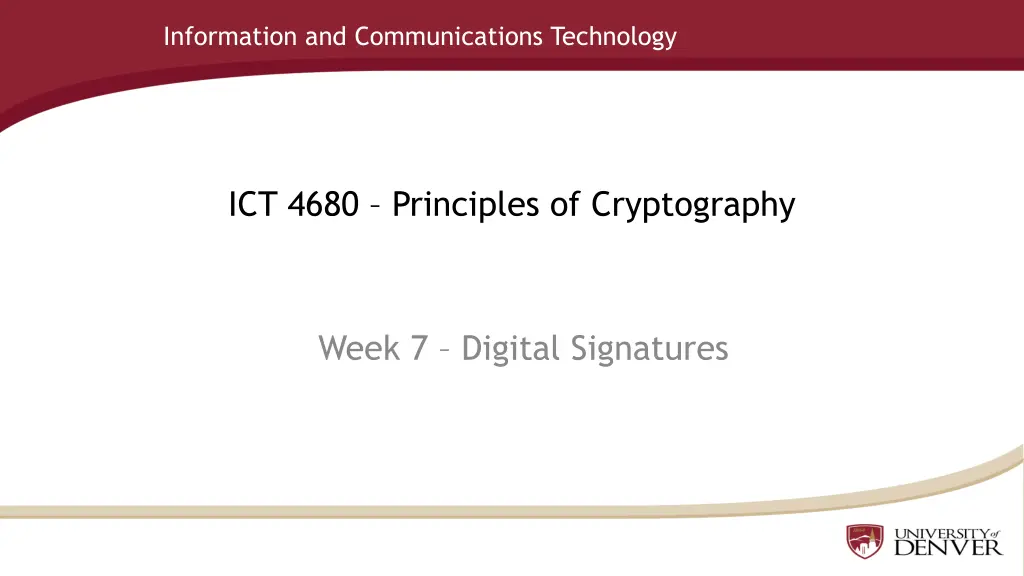
Understanding Digital Signatures in Information and Communications Technology
Explore the concept of digital signatures in ICT, covering their importance in message authentication, non-repudiation, and data integrity. Learn about different types of digital signatures, their creation using RSA, and potential security challenges. Discover the role of hash functions and public key cryptography in the digital signature process.
Download Presentation

Please find below an Image/Link to download the presentation.
The content on the website is provided AS IS for your information and personal use only. It may not be sold, licensed, or shared on other websites without obtaining consent from the author. If you encounter any issues during the download, it is possible that the publisher has removed the file from their server.
You are allowed to download the files provided on this website for personal or commercial use, subject to the condition that they are used lawfully. All files are the property of their respective owners.
The content on the website is provided AS IS for your information and personal use only. It may not be sold, licensed, or shared on other websites without obtaining consent from the author.
E N D
Presentation Transcript
Information and Communications Technology ICT 4680 Principles of Cryptography Week 7 Digital Signatures
Information and Communications Technology So far . You have learnt about RSA, AES, PKI and Hashes This week, you will apply all that learning to understand digital signatures. Explain the concept of a digital signature Recognize that not all digital signatures rely on public key cryptography Appreciate the role that hash functions play in creating digital signatures Demonstrate how digital signatures can be created and verified using RSA Differentiate between digital signatures with appendix and digital signatures with message recovery Distinguish between the properties of digital and hand-written signatures Identify some of the main ways in which digital signature schemes can be attacked
Information and Communications Technology Informal Definition Informally, a digital signature is a technique for establishing the origin of a particular message in order to settle later disputes about what message (if any) was sent. The purpose of a digital signature is thus for an entity to bind its identity to a message. We use the term signer for an entity who creates a digital signature, and the term verifier for an entity who receives a signed message and attempts to check whether the digital signature is correct or not. Digital signatures have many attractive properties and it is very important to understand exactly what assurances they provide and what their limitations are. While data confidentiality has been the driver behind historical cryptography, digital signatures could be the major application of cryptography in the years to come. 3
Information and Communications Technology Advanced Electronic Signature The European Community Directive on electronic signatures also refers to the concept of an advancedelectronic signature as: an electronic signature that is: 1. uniquely linked to the signatory 2. capable of identifying the signatory 3. created using means under the sole control of the signatory 4. linked to data to which it relates in such a way that subsequent changes in the data is detectable 4
Information and Communications Technology Security Requirements We will define a digital signature on a message to be some data that provides: Data origin authentication of the signer A digital signature validates the message in the sense that assurance is provided about the integrity of the message and of the identity of the entity that signed the message. Non-repudiation A digital signature can be stored by anyone who receives the signed message as evidence that the message was sent and of who sent it. This evidence could later be presented to a third party who could use the evidence to resolve any dispute that relates to the contents and/or origin of the message. 5
Information and Communications Technology Input to a Digital Signature The message Since a digital signature needs to offer data origin authentication (and non-repudiation) it is clear that the digital signature itself must be a piece of data that depends on the message, and cannot be a completely separate identifier. It may be sent as a separate piece of data to the message, but its computation must involve the message. A secret parameter known only by the signer Since a digital signature needs to offer non-repudiation, its calculation must involve a secret parameter that is known only by the signer. The only possible exception to this rule is if the other entity is totally trusted by all parties involved in the signing and verifying of digital signatures. 6
Information and Communications Technology Digital Signature Properties Easy for the signer to sign a message There is no point in having a digital signature scheme that involves the signer needing to use slow and complex operations to compute a digital signature. Easy for anyone to verify a message Similarly we would like the verification of a digital signature to be as efficient as possible. Hard for anyone to forge a digital signature It should be practically impossible for anyone who is not the legitimate signer to compute a digital signature on a message that appears to be valid. By appears to be valid we mean that anyone who attempts to verify the digital signature is led to believe that they have just successfully verified a valid digital signature on a message. 7
Information and Communications Technology Digital Signature Arbitration 2 3 KS KV Arbitrator 1 4 KS KV Signer Verifier 8
Information and Communications Technology True Digital Signatures The vast majority of digital signature techniques do not involve having to communicate through a trusted arbitrator. A true digital signature is one that can be sent directly from the signer to the verifier. For the rest of this unit when we say digital signature we mean true digital signature . True digital signature requirements Public key encryption requirements Only the holder of some secret data can sign a message Anyone can encrypt a message Only the holder of some secret data can decrypt a message Anyone can verify that a signature is valid 9
Information and Communications Technology Applications of Hash Functions Digital signatures with appendix: hash-functions are used to bind data together and make the signature process more efficient. Password storage: hash-functions are sometimes used to store highly confidential data such as passwords. Cryptographic protocols: hash-functions are often used within cryptographic protocols (including entity authentication protocols) to bind different data items together. Hash-functions can be used as components from which to construct other cryptographic primitives . 10
Information and Communications Technology MAC == Hash Function True or False? Have a fixed length output Rely on a symmetric key Provide data origin authentication (and data integrity) Typically constructed from block ciphers or hash functions Is a MAC a hash function? 11
Information and Communications Technology Digital signature algorithms
Information and Communications Technology Some Caveats to be aware of This section is focused on describing digital signatures based on RSA. Please note: Although we only describe in detail how to implement digital signatures using RSA, there are many other examples of (true) digital signatures that are not based on RSA The RSA public key cipher system has some special properties that allow it to be used for both encryption and digital signatures not all public key cipher systems can be used to generate digital signatures, and neither can all digital signature algorithms be used as public key cipher systems We will see two different methods of implementing true digital signatures using RSA these two techniques can also be used for some other digital signature algorithms The process described here is simplified please consult relevant standards before making an actual implementation 13
Information and Communications Technology Creating an RSA Signature with an Appendix message 1 hash function message 3 signature hash signature 2 Signature algorithm signature key 14
Information and Communications Technology Verifying an RSA Signature with Appendix message 1 2 signature hash function Verification algorithm verification key = ? Decision 3 15
Information and Communications Technology Key Separation In real applications you should avoid using the same RSA key pair for both encryption and for digital signatures. The reason is that good key management follows a principle known as key separation, where any cryptographic key has a specific role and is not used for different purposes. Thus, properly implemented versions of RSA that are to be used for both encryption and digital signatures should issue each user with two key pairs: a public / private key pair for encryption a verification / signature key pair for digital signatures These different key pairs should be carefully managed to ensure that they are only used for the designated purpose. 16
Information and Communications Technology RSA Signatures with Message Recovery message message add remove padding / redundancy Verifier padding / redundancy Signer 1 4 Signature algorithm verification key signature key Verification algorithm 2 3 signature 17
Information and Communications Technology Digital Signature Algorithm Although there have been many different proposals for digital signature schemes, only two systems have thus far proved to be fairly popular. RSA digital signatures are one, and the other is a digital signature scheme based on ElGamal that was proposed as the Digital Signature Algorithm (DSA) and standardised by the U.S. Government as the Digital Signature Standard. The DSA is a digital signature with appendix, but it cannot be used as a public key encryption system in the same way that RSA can be it is a dedicated digital signature scheme. 18
Information and Communications Technology Security issues
Information and Communications Technology Two Generic Attacks Obtain someone else s private signature key In a digital signature scheme you are your private key . This is one aspect of the problem of identity theft. Persuade others that someone else s public verification key belongs to you Others will verify it and believe that the message was signed by you. This is a particularly neat attack because you do not need to obtain that other person s signature key An interesting variant of this attack for hand-written signatures arises if you steal someone else s mail when a new credit card is sent out to them if you just sign this blank card then you can easily masquerade as them. 20
Information and Communications Technology Security of Hash Functions Suppose that we sign the message Matt owes John $10 by hashing it using a hash function that has a hash of just 2 bits: there are only four possible hashes: 00, 01, 10 or 11. Fred receives this signed message, and being a manipulative type he decides to change the message to Matt owes John $ 100. Of course John does not have Matt s signature key, so he cannot digitally sign this message. But he doesn t have to he only has to sign the hash! What is the probability that: hash (Matt owes John $10 ) = hash (Matt owes John $100 )? 21
Information and Communications Technology Secure Hash Functions In practice a common practical length for a hash is about 160 bits. This makes finding collisions of the type just described extremely unlikely, and also represents a significant compacting of the original message length. Much shorter hashes than 160 bits are insecure, as we have seen. Much longer hashes than 160 bits might be secure, but are not as efficient. Finding good hash functions has proven to be a significant challenge to cryptographers. 22
Information and Communications Technology In Summary Digital signatures are in some senses a complimentary technology to public key encryption, offering data origin authentication and non-repudiation of digital messages. Digital signatures have different properties and offer different guarantees to hand-written signatures. The security of digital signatures critically relies on the security of the keys that are used to create and verify them. 23



